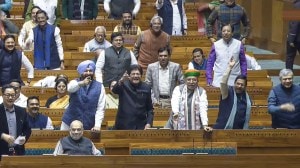Justice Gavai nominated as SC Legal Services Committee Chairman: What law says on free legal aid in India
What does the committee's mandate say, and who nominates members to it? What is the need for legal aid? We explain.
 In 1987, the Legal Services Authorities Act was enacted to give a statutory base to legal aid programmes. It aims to provide free and competent legal services to eligible groups, including women, children, SC/ST and EWS categories, industrial workers, disabled persons, and others. (Via Pixabay)
In 1987, the Legal Services Authorities Act was enacted to give a statutory base to legal aid programmes. It aims to provide free and competent legal services to eligible groups, including women, children, SC/ST and EWS categories, industrial workers, disabled persons, and others. (Via Pixabay)Supreme Court judge Justice BR Gavai has been nominated as the Chairman of the Supreme Court Legal Services Committee (SCLSC), replacing Justice Sanjiv Khanna – the seniormost judge of the top court after the Chief Justice of India (CJI).
A notification issued by the Department of Justice on December 29, 2023, announced Justice Gavai’s nomination. Here is what the committee is, and what the law says on legal services in India.
What is the Supreme Court Legal Services Committee?
The Supreme Court Legal Services Committee was constituted under Section 3A of the Legal Services Authorities Act, 1987, to provide “free and competent legal services to the weaker sections of society”, in cases falling under the top court’s jurisdiction.
Section 3A of the Act states that the Central Authority (the National Legal Services Authority or NALSA) shall constitute the committee. It consists of a sitting SC judge, who is the chairman, along with other members possessing the experience and qualifications prescribed by the Centre. Both the chairman and other members will be nominated by the CJI. Further, the CJI can appoint the Secretary to the Committee.
Who does the SCLSC comprise?
As of date, the SCLSC consists of chairperson BR Gavai and nine members nominated by the CJI. The Committee, in turn, can appoint officers and other employees as prescribed by the Centre, in consultation with the CJI.
Besides this, Rule 10 of the NALSA Rules, 1995, entails the numbers, experience, and qualifications of the SCLSC members. Under Section 27 of the 1987 Act, the Centre is empowered to make rules in consultation with the CJI, by notification, to carry out the provisions of the Act.
What is the need for legal services and how is it dispensed to the people?
The need for providing legal services has been underlined in many provisions of the Indian Constitution. Article 39A states, “The State shall secure that the operation of the legal system promotes justice, on a basis of equal opportunity, and shall, in particular, provide free legal aid, by suitable legislation or schemes or in any other way, to ensure that opportunities for securing justice are not denied to any citizen by reason of economic or other disabilities.”
Moreover, Articles 14 (right to equality) and 22(1) (rights to be informed of grounds for arrest) also make it obligatory for the State to ensure equality before the law and a legal system that promotes justice based on equal opportunity.
Although the idea of a legal aid programme was earlier floated in the 1950s, it was in 1980 that a committee at the national level was established under the chairmanship of then SC judge Justice PN Bhagwati. The Committee for Implementing Legal Aid Schemes started monitoring legal aid activities throughout India.
What the Legal Services Authorities Act says
In 1987, the Legal Services Authorities Act was enacted to give a statutory base to legal aid programmes. It aims to provide free and competent legal services to eligible groups, including women, children, SC/ST and EWS categories, industrial workers, disabled persons, and others.
Under the Act, NALSA was constituted in 1995 to monitor and evaluate the implementation of legal aid programmes and to lay down policies for making legal services available. A nationwide network has been envisaged under the Act for providing legal aid and assistance. It also disburses funds and grants to State Legal Services Authorities and NGOs for implementing legal aid schemes and programmes.
Subsequently, in every state, State Legal Services Authorities (SLSA) were established to implement NALSA’s policies and directions, give free legal services to people, and conduct Lok Adalats. An SLSA is headed by the Chief Justice of the respective High Court and includes the senior HC judge as its Executive Chairman. While the HC Chief Justice is the patron-in-chief of the SLSA, the CJI is the patron-in-chief of NALSA.
Similarly, District Legal Services Authorities (DLSAs) and Taluk Legal Services Committees were established in districts and most taluks. Situated in the District Courts Complex in every district, each DLSA is chaired by the District Judge of the respective district.
The Taluka or Sub-Divisional Legal Services Committees are headed by a senior civil judge. Collectively, these bodies organise legal awareness camps, provide free legal services, and supply and obtain certified order copies and other legal documents, among other functions.
- 01
- 02
- 03
- 04
- 05






































